Are you a Quiet Speculation member?
If not, now is a perfect time to join up! Our powerful tools, breaking-news analysis, and exclusive Discord channel will make sure you stay up to date and ahead of the curve.
Dominaria's been Modern-legal for almost two months, and a host of players have tried their hand at brewing with Mox Amber, including yours truly. While more aggressive lists than mine have put up 5-0s here and there, the card has mostly fallen flat, as many expected. But the few results Amber has scored inspired me to revisit the card, which I still think has potential in Modern.

This article explains the possible directions I see white-based Amber shells going, and unveils my Naya Legends deck.
Metagame Niche
Creature-heavy aggro-control deck with fast mana. Sound familiar? The recipe's no stranger to Modern, and Legends occupies some of the same metagame ground as Affinity and Humans. This section illustrates its pros and cons over each.
Legends vs. Affinity
 While it feels a bit obtuse to immediately compare Legends to Modern's other Mox-touting aggro deck, the parallels do exist. Affinity too uses sub-par creatures to power out dangerous threats ahead of curve. In practice, though, Mox Amber is a bit closer to Springleaf Drum than to Mox Opal; it requires a creature in play to tap for mana, and since our cheapest creatures cost one, we can't activate Amber without spending something. After the first tap, however, it goes back to being a Mox. It's also like a mana dork in this regard.
While it feels a bit obtuse to immediately compare Legends to Modern's other Mox-touting aggro deck, the parallels do exist. Affinity too uses sub-par creatures to power out dangerous threats ahead of curve. In practice, though, Mox Amber is a bit closer to Springleaf Drum than to Mox Opal; it requires a creature in play to tap for mana, and since our cheapest creatures cost one, we can't activate Amber without spending something. After the first tap, however, it goes back to being a Mox. It's also like a mana dork in this regard.
The most obvious edge Legends has over Affinity, which is otherwise a more proactive and all-around powerful deck, is resilience. Sure, most shells are soft to damage-based sweepers like Pyroclasm. But so is Affinity, and those cards are far rarer in Modern than artifact hate. Clasm even hurts Legends less than something like Ancient Grudge or Stony Silence hurts Affinity, and that's without mentioning absolute hosers such as Shatterstorm (which, as we'll see, Legends itself basically gets to run).
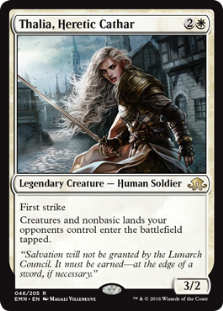 To compensate for its dip in proactivity relative to Affinity, Legends becomes interactive; à la fish, with creatures. Both Thalias headline the deck's disruption suite, with the first and smallest serving as its primary cog. Thalia, Guardian of Thraben is a cornerstone of creature-heavy aggro strategies from Humans to Bant Eldrazi, and for good reason: she forces spell-based combo (read: Storm) to deal with her before claiming a win, hassles three-color midrange decks like Jeskai, and passes the Bolt Test by rewriting its very rules.
To compensate for its dip in proactivity relative to Affinity, Legends becomes interactive; à la fish, with creatures. Both Thalias headline the deck's disruption suite, with the first and smallest serving as its primary cog. Thalia, Guardian of Thraben is a cornerstone of creature-heavy aggro strategies from Humans to Bant Eldrazi, and for good reason: she forces spell-based combo (read: Storm) to deal with her before claiming a win, hassles three-color midrange decks like Jeskai, and passes the Bolt Test by rewriting its very rules.
Thalia, Heretic Cathar is more complicated, but equally devastating in Legends. Mox Amber provides an attractive way to slam her early, which spells doom for many Modern decks, and especially ones with fetchlands. Since Cathar's primary purpose is stunting enemy development, she's at her best when the pressure is magnified; turn one beater, turn two Cathar off a Mox is a line that creates that sort of clock, and sure beats casting her off a Birds of Paradise.
Finally, the creatures in Legends hold their own better than Affinity's do. Against a removal-heavy opponent, Affinity is liable to be left with some useless Memnites and Ornitopters unless it can find Cranial Plating. Not so with Legends, whose pseudo-Springleaf-enablers serve as reasonable attackers. Our grind game is helped further by haymakers like Shalai, Voice of Plenty, as well as token generators like Rhys the Redeemed.
Legends vs. Humans
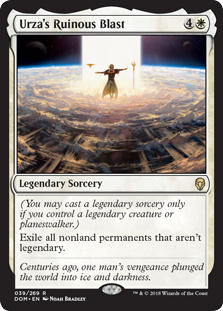 Humans is another deck that begs comparison to Legends. Like Affinity, it's an overall better deck thanks to its proactivity and consistency, which Legends rarely achieves. Humans also takes our disruptive gameplan to the next level with Kitesail Freebooter, Meddling Mage, and Reflector Mage, and even runs both Thalias.
Humans is another deck that begs comparison to Legends. Like Affinity, it's an overall better deck thanks to its proactivity and consistency, which Legends rarely achieves. Humans also takes our disruptive gameplan to the next level with Kitesail Freebooter, Meddling Mage, and Reflector Mage, and even runs both Thalias.
Our big trump over Humans is Urza's Ruinous Blast. This one-sided Oblivion Ring-plus is ridiculous in many matchups, and a major draw to the archetype. Mox Amber and other fast mana cards make casting it a breeze, especially in slower post-board games; Blast's hefty mana cost also offsets the now-infamous "Humans problem" of flooding out in the mid-game, as Drowner of Hope did for Bant Eldrazi many moons ago. It also doesn't hurt that Humans and Affinity are two of the matchups most hurt by our Blasts, although Lantern Control deserves an honorable mention.
Deckbuilding Options
Legends can easily manage reaching into a nonwhite color. Green and red, not coincidentally the only other colors featuring one-drop legends, seem like the best splashes. Each offers the deck something unique.
Green
Noble Hierarch: The biggest reason to go green, Hierarch doubles us up on fast mana sources, allowing for explosives starts and incentivizing opponents to spend their first turn reacting to our play. The dork's also a literal lightning rod, drawing fire away from the fragile Thalia, Heretic Cathar.
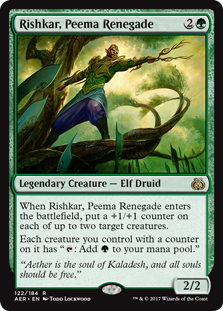 Oviya Pashiri, Sage Lifecrafter: Oviya is probably the worst one-drop legend in this deck, if only for her overlap with Rhys. We prefer the latter because of its mana smoothing qualities when combined with Mox Amber. That said, she's still a one-mana legend, and we can't get enough of those; the more names we run, the less chance we have of bricking with identical legends or opening anemic Moxen.
Oviya Pashiri, Sage Lifecrafter: Oviya is probably the worst one-drop legend in this deck, if only for her overlap with Rhys. We prefer the latter because of its mana smoothing qualities when combined with Mox Amber. That said, she's still a one-mana legend, and we can't get enough of those; the more names we run, the less chance we have of bricking with identical legends or opening anemic Moxen.
Rishkar, Peema Renegade: While unexciting on the surface, Rishkar impressed me in testing. He grows our smaller creatures into Wild Nacatls and ramps us right into whatever pricey spell we're looking to cast.
Reki, the History of Kamigawa: I had Reki in most of my GW builds. The creature provides plenty of advantage—turn one Untaidake, the Cloud Keeper, turn two Reki into Mox and a one-drop puts us far ahead of opponents on cards, and things continue snowballing from there. But Reki's fairly build-around, all but necessitating many Untaidakes, and some opponents could care less about our card advantage, instead daring us to just kill them quickly.
Red
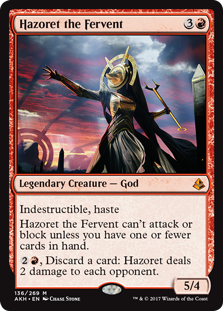 Zurgo Bellstriker: Red's Oviya analogue: trash, but a name.
Zurgo Bellstriker: Red's Oviya analogue: trash, but a name.
Hazoret the Fervent: A terrific reason to go red, Hazoret supports our natural gameplan of dump hand, attack, and pressures opponents from some unique angle: it's impervious to many types of removal, can kill planeswakers (and players) out of nowhere, and gives us repeated reach.
Utility options: Nothing in green had me tickled on this front, but red offers many intriguing utility options. I've integrated a few into the build I settled on, which ended up splashing both colors.
Stirring the Soup
Naya Legends, by Jordan Boisvert
Philosophy
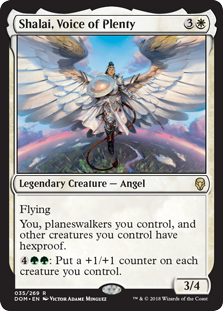 Running all three colors lets us play every relevant one-drop legend in Modern. Combined with a full set of Hierarchs, all those cheap legends maximize the odds of getting to three mana on turn two, and to four mana on turn three.
Running all three colors lets us play every relevant one-drop legend in Modern. Combined with a full set of Hierarchs, all those cheap legends maximize the odds of getting to three mana on turn two, and to four mana on turn three.
The rest of the deck seeks to capitalize on that advantage by either blitzing opponents with cheap legends or locking them out of the game, draws depending. At the top of the curve, Shalai and Hazoret lock things up, making it impossible for opponents to cleanly answer our boards. Shalai's activated ability also comes up in longer games, mitigating flood.
Red Utility
I found myself in want of more permanent disruption at three mana, and eventually added Blood Moon. The very threat of a turn two Moon from us, even when we don't start on a mana dork, spooks opponents stiff. They're also likelier to expect it post-board, after having seen the enchantment; many of my board plans involve removing Moon, though, and bringing in Blast. We end up benefiting from the card a disproportionate amount as opponents fetch badly in fear.
 We lack the built-in creature interaction of Reflector Mage, but must play some form of efficient removal to survive and cast our funny Standard cards. Lightning Bolt helps us survive the early turns against the more proactive creature decks, and its reach plays nice with our Zoo-like assault of legendary bodies.
We lack the built-in creature interaction of Reflector Mage, but must play some form of efficient removal to survive and cast our funny Standard cards. Lightning Bolt helps us survive the early turns against the more proactive creature decks, and its reach plays nice with our Zoo-like assault of legendary bodies.
The flashiest include is probably Faithless Looting, a longtime pet card of mine that's at last garnered widespread attention as a defensible Modern cantrip. Looting lets us chew through redundant legends and lock pieces, but primarily gets us through chunks of lands: with Moon on the table, Horizon Canopy shuts off, and Canopy couldn't totally offset our flooding in the GW builds anyway. Early adopters of Mox Amber used Smuggler's Copter for this purpose, but I prefer the immediate draw in this build. Copter dies to Blast, flashback is easy to pay, and Looting has natural synergy with Hazoret.
Lands and Sideboard
The lone Untaidake may get cut soon, but the early Shalais, Hazorets, and Cathars are awesome when they do happen. The Sol land is also better post-board, when Moon frequently becomes Blast. Eiganjo Castle feels like a necessary evil against Bolt decks, primarily to protect Cathar. I'm looking to test a Mountain and try dropping down to 21 lands.
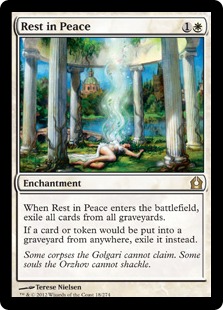 I started with Rest in Peace in the sideboard, but the enchantment had too much tension with Blast, so I replaced it with Relic. The eight legendary creatures all come in against different opponents, often for Looting (our curve increases post-board) or Hierarch (especially weak to damage-based sweepers and dies to Blast), or for whatever legend's bad in the matchup (i.e. Guardian of Thraben vs. Humans). I'm still testing the lot of them to see which ones I want to keep.
I started with Rest in Peace in the sideboard, but the enchantment had too much tension with Blast, so I replaced it with Relic. The eight legendary creatures all come in against different opponents, often for Looting (our curve increases post-board) or Hierarch (especially weak to damage-based sweepers and dies to Blast), or for whatever legend's bad in the matchup (i.e. Guardian of Thraben vs. Humans). I'm still testing the lot of them to see which ones I want to keep.
As the numbers indicate, the sideboard is built around Urza's Ruinous Blast. Four copies may be too many, but I want to draw it every game when I do bring it in. We can also pitch spares to Looting.
Underneath the Blood Orange Sun
Naya Humans is a brand-new brew, and quite unrefined at this point. It's fully possible I'm being too greedy on three colors and should stick with two, as have the Modern players achieving modest successes with the strategy. In any case, I know I'm still having fun playing around with the cards after a week, which bodes well for my future development of the deck. If you have any comments or suggestions, manage to take the deck out for a spin, or would like to share about your own experience with Mox Amber, drop me a line in the comments.





Finally I see the new brew!
Did you consider Gaddock Teeg? He would probably have to be mainboard if your sideboard plan is Ruinous Blast, but he hoses a lot of decks right now: Storm, Tron, Control, CoCo, etc.
Too narrow and pricey for the mainboard and clashes often with our sideboard plans. We have other ways of interacting with Storm (Thraben, Relic), Tron (Blast, Cathar), and control (Shalai, Moon).
Ws pretty surprised to not see time of need and a toolbox in there. Lowers the number of duplicated legends, smoothes curves, give access to tutorsble hate.
This deck is more about creating a clock than tutoring up bullets. Time is also pretty inefficient and clashes with Thalia.
I’ve been on a bant version myself, so I get to run a spirits style deck with geist rmage and queller, and Amber making those landing turn 2 even more consistent.
Hero’s blade is also a card to take note of, as it forces any controlling deck to have to deal with every single one of your threats, with little mana investment on your part. It would be a 2 of at most, but a good card nevertheless.
2 cards that have overpreformed for me are yasova, and also alesha when I was running the red splash. The deck ends up with about 20 humans, too, so lieutenant is a decent include as well.